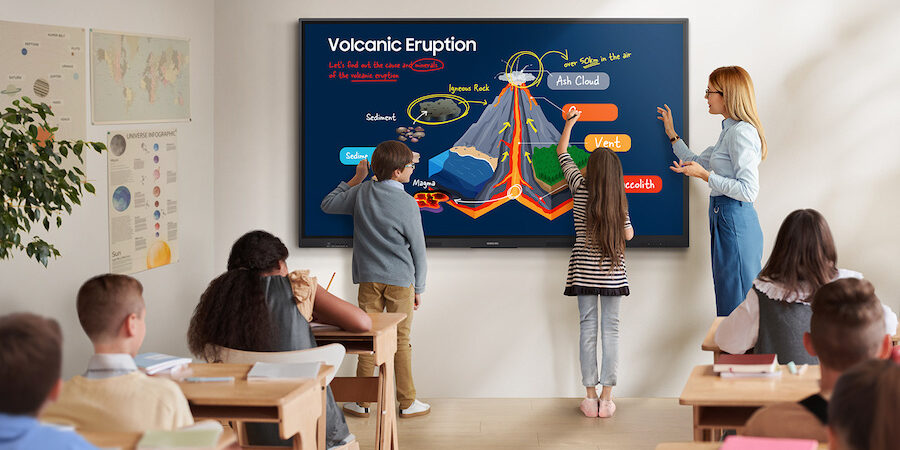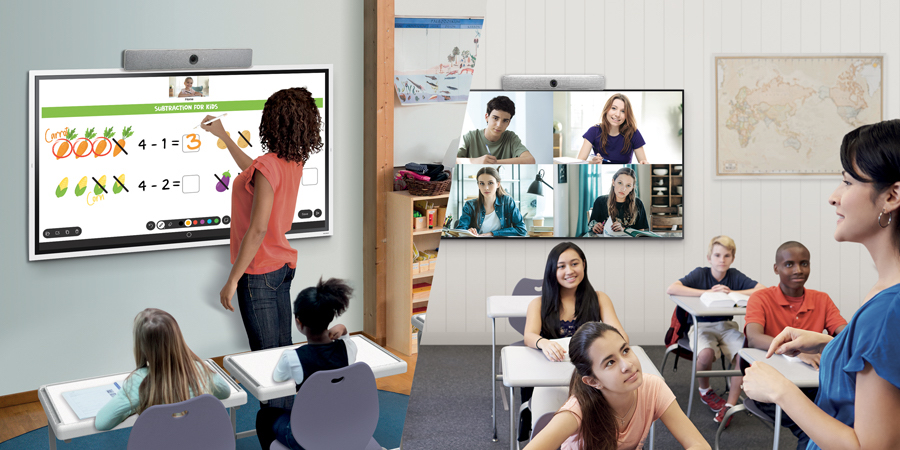A recent crossword clue explains it all: “Obsolescent classroom wall fixture.” The answer, blackboard, is a reminder that smart boards are the de facto standard in most classrooms nationwide. Still, some teachers may not know how to use a smart board in the classroom and effectively incorporate them into their lesson plans.
How can you incorporate smart boards in your K-12 lesson plans?
Education technology teacher Matt Miller loves using interactive panels to center his learning stations. “Students have a variety of tasks they do all around the room, and they rotate from station to station,” said Miller in a Q&A with Samsung. Students can draw on the whiteboard or use the built-in web browser to pull up an interactive map or educational app. “Whenever students get to lay hands on these devices, they can create. Anything that takes learning out of the hands of the teacher and puts it into the hands of the students are some of the best opportunities you get.”
Blended learning without limits
Simple, scalable and secure display solutions empower educators to take control of curriculum. Download Now
That’s just one example of how teachers can utilize interactive whiteboards. The technology, which is becoming more widely adopted in schools nationwide, has also been proven to help students stay engaged with their schoolwork.
Student engagement is a significant problem in today’s classrooms. In 2024, nearly half of all teachers reported declining student engagement, according to a survey-based report. Created by the Harris Poll for Discovery Education, the same study found that more than 8 in 10 students say there are not enough opportunities to be curious in the classroom — and three-quarters of teachers agree.
That’s why technology tools that help teachers capture and keep students’ attention can be invaluable. As noted by eSchoolNews, integrating technology into the classroom equips students with the skills needed to tackle future challenges while enhancing the effectiveness and inclusivity of education.
Smart boards — also called interactive whiteboards or panels — improve the learning experience while improving teachers’ lives. They allow teachers and students to learn collaboratively, share files, access online resources and use educational software.
Here are four top uses for smart boards in teaching and learning and how they can benefit every student.
1. Boost student engagement
Today’s K-12 students are digital natives, and they learn better because of it.
With smart boards, like Samsung’s Interactive Display WAF Series, teachers can create more dynamic lessons by writing or typing on the screen, calling attention to certain topics with highlights, circles, arrows, or zooming in, and sharing multimedia content such as videos, webpages, presentations and images. Plus, since the WAF Series is EDLA-certified, teachers can run Google tools such as Google Classroom, Slides, and Docs, pull up YouTube, and access the Google Play Store right from the interactive whiteboard.
This is all thanks to the WAF Series being powered by Android OS 14. The smart board can be divided into multiple sections so more than one student can work on it simultaneously. All three displays in the WAF Series support up to 40 simultaneous touchpoints, allowing groups of students to write or draw at the same time. In addition, the dual pen function enables the use of two different writing tools with no downtime.
2. Make the classroom work for everyone
What works for one student might not work for another. However, the WAF Series has a familiar and easy-to-use interface. Teachers and students can choose from a variety of widgets, while its easily customizable home screen provides the flexibility needed to build an environment suited for various learning needs. For instance, students who get overwhelmed with spoken lessons can click on an Annotation button whether they are watching a video or viewing another piece of content, and it will take notes automatically. Teachers can also create a split screen, showing different learning tools to give students more entry points to a lesson.
The Samsung WAF Interactive Display’s AI solution is another valuable tool for teachers and students. This includes Circle to Search with Google, which provides a new way to search the internet directly from the display to support students’ understanding. Just circle an image or text, and additional resources, such as translations or definitions, will appear in a pop-up window.
WAF’s AI Assistant tool has a voice transcription feature that lets teachers capture their lesson or lecture through a webcam or Bluetooth microphone they are already using. When done teaching the lesson, they can access the full transcription, create an instant summary (including headers and timestamps) and share it with students. You can also generate study guides, lecture notes and more. This makes it easier for all students, including those who may need additional support, to review key concepts, stay on track with the material and reinforce their understanding at their own pace.
3. Accommodate different learning styles
Whether a child is a visual learner, an auditory learner or a kinesthetic (hands-on) learner, an interactive whiteboard can benefit them. Visual learners can view everything on a large screen — Samsung WAF Series 4K graphic displays come in 65-, 75-, and 86-inch models — while auditory learners can listen to multimedia content and hands-on learners can write on the board with a stylus or even their finger. Educators can use the smart board to teach small groups, organized by learning style, or one-on-one with individual students. Using the WAF Series HDMI-Out functionality, content can be shared on multiple screens within the classroom so students can learn from wherever they are within the room without moving seats.
4. Save, share and send lessons
When students are out sick, K-12 teachers typically spend time creating work packets for them to catch up. With a smart board, this process is easier since teachers can screenshot their lessons and instantly save and share them with students and colleagues as needed. Or they can record the entire lesson with the recording feature. The content options are limitless: Teachers can save their notes to pick up where they left off or create review materials for students to bring home to study and share them easily through apps like Google Classroom. This is especially beneficial for students trailing their peers, as they no longer have to take notes in real time while struggling to keep pace with the lesson. If they miss something, they can easily refer back to it on their own time.
At the beginning of the day, smart board startup is easy — just turn it on and go. And at the end of the day, teachers can turn off the board without erasing anything or taking physical notes on what they covered.
Given all the ways interactive smart boards enhance the learning experience, school districts that invest in smart boards are investing in their students.
You can find the right classroom display for your students’ needs — and for your budget — by exploring Samsung’s full lineup of versatile interactive displays. And discover how simple, scalable and secure display solutions can empower educators to take control of the curriculum in this free guide.








